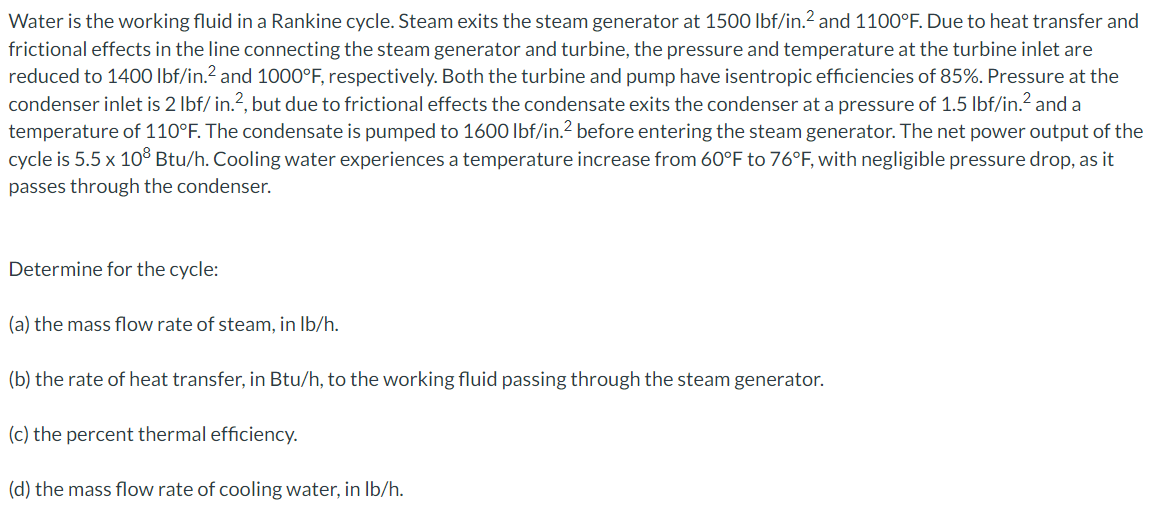Determine for the cycle: (a) the mass flow rate of steam, in Ib/h. b) the rate of heat transfer, in Btu/h, to the working fluid passing through the steam generator. (c) the percent thermal efficiency.
Determine for the cycle: (a) the mass flow rate of steam, in Ib/h. b) the rate of heat transfer, in Btu/h, to the working fluid passing through the steam generator. (c) the percent thermal efficiency.
Elements Of Electromagnetics
7th Edition
ISBN:9780190698614
Author:Sadiku, Matthew N. O.
Publisher:Sadiku, Matthew N. O.
ChapterMA: Math Assessment
Section: Chapter Questions
Problem 1.1MA
Related questions
Question

Transcribed Image Text:Water is the working fluid in a Rankine cycle. Steam exits the steam generator at 1500 lbf/in.? and 1100°F. Due to heat transfer and
frictional effects in the line connecting the steam generator and turbine, the pressure and temperature at the turbine inlet are
reduced to 1400 Ibf/in.? and 1000°F, respectively. Both the turbine and pump have isentropic efficiencies of 85%. Pressure at the
condenser inlet is 2 Ibf/ in.?, but due to frictional effects the condensate exits the condenser at a pressure of 1.5 lbf/in.? and a
temperature of 110°F. The condensate is pumped to 1600 lbf/in.² before entering the steam generator. The net power output of the
cycle is 5.5 x 10³ Btu/h. Cooling water experiences a temperature increase from 60°F to 76°F, with negligible pressure drop, as it
passes through the condenser.
Determine for the cycle:
(a) the mass flow rate of steam, in Ib/h.
(b) the rate of heat transfer, in Btu/h, to the working fluid passing through the steam generator.
(c) the percent thermal efficiency.
(d) the mass flow rate of cooling water, in Ib/h.
Expert Solution
This question has been solved!
Explore an expertly crafted, step-by-step solution for a thorough understanding of key concepts.
Step by step
Solved in 3 steps

Knowledge Booster
Learn more about
Need a deep-dive on the concept behind this application? Look no further. Learn more about this topic, mechanical-engineering and related others by exploring similar questions and additional content below.Recommended textbooks for you

Elements Of Electromagnetics
Mechanical Engineering
ISBN:
9780190698614
Author:
Sadiku, Matthew N. O.
Publisher:
Oxford University Press

Mechanics of Materials (10th Edition)
Mechanical Engineering
ISBN:
9780134319650
Author:
Russell C. Hibbeler
Publisher:
PEARSON

Thermodynamics: An Engineering Approach
Mechanical Engineering
ISBN:
9781259822674
Author:
Yunus A. Cengel Dr., Michael A. Boles
Publisher:
McGraw-Hill Education

Elements Of Electromagnetics
Mechanical Engineering
ISBN:
9780190698614
Author:
Sadiku, Matthew N. O.
Publisher:
Oxford University Press

Mechanics of Materials (10th Edition)
Mechanical Engineering
ISBN:
9780134319650
Author:
Russell C. Hibbeler
Publisher:
PEARSON

Thermodynamics: An Engineering Approach
Mechanical Engineering
ISBN:
9781259822674
Author:
Yunus A. Cengel Dr., Michael A. Boles
Publisher:
McGraw-Hill Education

Control Systems Engineering
Mechanical Engineering
ISBN:
9781118170519
Author:
Norman S. Nise
Publisher:
WILEY

Mechanics of Materials (MindTap Course List)
Mechanical Engineering
ISBN:
9781337093347
Author:
Barry J. Goodno, James M. Gere
Publisher:
Cengage Learning

Engineering Mechanics: Statics
Mechanical Engineering
ISBN:
9781118807330
Author:
James L. Meriam, L. G. Kraige, J. N. Bolton
Publisher:
WILEY